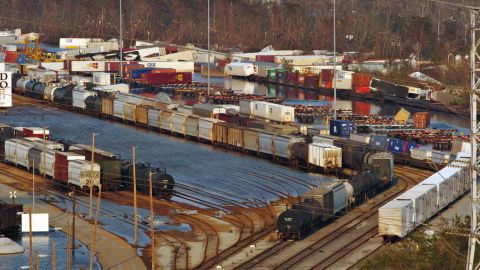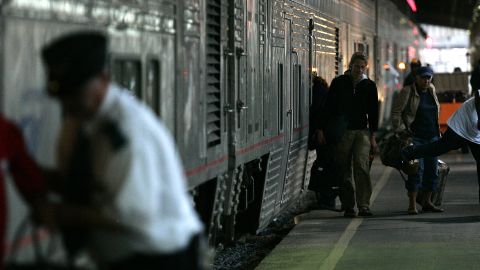Amtrak dumps its nice guy persona in fight for Gulf Coast trains
Washington, DC
CNN
—
Amtrak is embroiled in a fight that may have vast implications for the future of US rail service, including the billions of dollars devoted to it from the bipartisan infrastructure bill.
Amtrak, which typically speaks in a mild-mannered tone on social media, has reinvented itself as a flamethrower that’s launching snarky missives at the freight railroad companies that it says are blocking passenger train travel on the Gulf Coast.
Amtrak trains outside the Northeast corridor generally run on tracks owned by freight railroads, sharing the tracks on an agreed upon schedule, though unexpected delays occur when the freight railroads deviate from the schedule and run their own trains hours ahead or behind schedule.
(The freight railroads generally face no penalty for doing so, as the Justice Department has only once acted against a freight railroad for failing to give Amtrak the priority US law requires.)
The relationship between Amtrak and these partners has long been contentious, with Amtrak describing the railroads as the largest cause of delays for its passengers. It began releasing an annual report card in 2018 that graded the railroads. Most receive low marks. Now, in a dispute with freight train operating companies CSX and Norfolk Southern, Amtrak is going even farther to make a point.
This month it joined the livestreaming website Twitch, where the account has shared videos mocking the number of trains that CSX runs between New Orleans and Mobile. “CSX’s Very Busy Gulf Coast Corridor,” it titled one video, which showed footage of empty rail tracks. Birds chirped in the background.
Amtrak wants to see its own trains return to these tracks, but the freight railroads haven’t agreed to doing so.

CSX spokesman Bryan Tucker described the video depicting the empty tracks a “gimmick,” and “grossly misleading.”
Amtrak’s new voice has earned it a level of engagement online that it hasn’t seen previously. A tweet earlier this year introducing the backstory on the Gulf Coast feud on its “Connect US” Twitter account received more retweets and likes than anything posted on its accounts this year.
CSX and Norfolk Southern, freight railroads that operate the tracks Amtrak would use, say that the new passenger service between New Orleans and Mobile, Alabama will negatively impact their business, and Amtrak needs to pay for infrastructure upgrades to prevent clogged rail lines. Amtrak has described the current request for $542 million to operate between New Orleans and Mobile, Alabama as a “ransom,” and doesn’t believe the railroads have shown an immediate need for new infrastructure to support passenger train service, as CSX and Norfolk Southern claim.
It remains to be seen if Amtrak’s new tactics to end a 16-year gap in service – Amtrak never resumed service in the region following Hurrican Katrina – will pay off. The Surface Transporation Board, a federal agency, has held hearings this month to resolve the conflict.
The Surface Transportation Board’s decision will set a precedent for what must be done before Amtrak can add service elsewhere in the United States, according to Knox Ross, chairman of the Southern Rail Commission, which promotes rail service on the Gulf.
“This is really a lot more than just can you run a couple passenger trains between New Orleans and Mobile,” Ross told CNN Business.
The bipartisan infrastructure bill passed in 2021 includes $66 billion for passenger and freight rail. President Biden has spoken of sparking a “second great railroad revolution.”
Amtrak released a plan in 2021 that called for as many as 30 new routes and more trains on 20 existing routes. In addition to the Gulf Coast route, service would begin in cities like Columbus, Ohio, Nashville, Tennessee, Las Vegas and Phoenix, Arizona.
CSX, which operates most of the tracks Amtrak would use in the Gulf Coast, said Amtrak is looking for a precedent that will allow it to force themselves on freight railroads without any study or consideration for infrastructure to accommodate new services.
“We’re not trying to stop a rail renaissance. Bring on the rail renaissance but do it in a responsible and a reasonable manner,” CSX’s Tucker said. The railroad wants studies conducted to make sure railroads aren’t negatively impacted, and infrastructure paid for to prevent disruptions to its service and customers.
Amtrak objects to the characterization and says it’s willing to work with railroads on infrastructure improvements that benefit everyone. The Southern Rail Commission, which supports Amtrak efforts, says it’s received a $66 million grant to make improvements.

The Gulf Coast is the latest place where acrimony between Amtrak and the freight railroads has played out.
“Federal law requires Amtrak to receive preference over freight but too often that law is ignored by some freight railroads,” Amtrak said in its 2021 report card on its host railroads. CSX received a “B” and Norfolk Southern a “D-,” from Amtrak.
Amtrak was formed in 1970 after rail companies struggled to turn a profit on passenger service and wanted to exit the business. They were hindered by federal regulations that set prices and could force railroads to operate unprofitable routes. The US government was also heavily subsidizing rail’s main competitor, the Interstate highways, while not providing similar investments in rail.
The US government agreed to create the government-backed Amtrak and allow the rail companies to halt passenger service provided that they allowed Amtrak to operate on their tracks.
Amtrak says that as early as 2006, a year after Hurricane Katrina, it reached out to CSX to start conversations about restoring service. Little progress was made.
Congress called for a report in 2015 to evaluate options for bringing back service. The study found that for $118 million, service could be restored from New Orleans to Mobile, plus all the way through to Orlando. CSX had said that for $2.3 billion, service could resume from New Orleans to Orlando, but even then on-time performance wouldn’t be guaranteed. Needed improvements include sidings, which are long sections of rail alongside the primary rail, where trains can pull onto temporarily so other trains can pass. Many of the tracks between New Orleans and Mobile are a single track, so passing is a challenge.
CSX says that today eight to 10 trains run daily all the way from New Orleans to Mobile, Alabama. It says that other trains sometimes make shorter trips on the stretch of tracks but declined to give an exact number. The eight to 10 through trains is about half the volume the freight railroads ran in 1996, according to Amtrak. Freight trains are longer today, however, which impacts how clogged a route is, and Amtrak plans to run more trains during popular daytime hours.
Amtrak contends that there is ample track for everyone and that what is needed is simply for freight train operators to yield space to passenger trains.
“We won’t waste taxpayer dollars to fix problems that have nothing to do with us,” Amtrak tweeted.
Read More: Amtrak dumps its nice guy persona in fight for Gulf Coast trains

